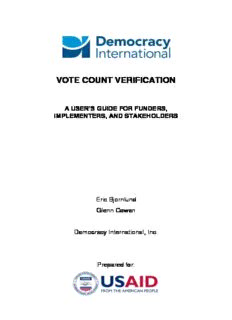
Vote Count Verification PDF
Preview Vote Count Verification
c VOTE COUNT VERIFICATION A USER’S GUIDE FOR FUNDERS, IMPLEMENTERS, AND STAKEHOLDERS Eric Bjornlund Glenn Cowan Democracy International, Inc. Prepared for: VOTE COUNT VERIFICATION A USER’S GUIDE FOR FUNDERS, IMPLEMENTERS, AND STAKEHOLDERS Eric Bjornlund Glenn Cowan Democracy International, Inc. Prepared for: © 2011 by Democracy International, Inc. All rights reserved Democracy International, Inc. 4802 Montgomery Lane Bethesda MD, 20814 +1.301-961-1660 www.democracyinternational.com This publication was made possible through the support of the U.S. Agency for International Devel- opment (USAID). The opinions expressed herein are those of the authors and do not necessarily re- flect the views of USAID. DEMOCRACY INTERNATIONAL Democracy International, Inc. (DI) provides technical assistance and analytical services and im- plements democracy and governance programs worldwide for the U.S. Agency for International Development (USAID) and other development partners (www.democracyinternational.com). DI offers substantive expertise across the full range of democracy and governance programming, including (1) elections and political processes (election man- agement and administration, voter education, inter- national and domestic election monitoring, political party development); (2) governance (local govern- ment and decentralization, legislative and institu- tional strengthening); (3) the rule of law (constitu- tional and legal reform, justice-sector reform, court administration, legal profession, anticorruption, human rights); and (4) civil society development and advocacy. The firm also offers recognized tech- nical expertise in analytical services, including sur- vey research, assessments, evaluations, project de- signs, and democracy assistance studies, as well as with strategic communications. Since its founding in 2003, Democracy Interna- tional has worked in more than 40 countries and in all regions of the world. In the past 25 years, DI‟s principals have advised and worked with election management bodies, civil society and election- monitoring organizations, political parties, legisla- tures, government agencies, and others in more than 70 countries. CONTENTS CHAPTER 1: OVERVIEW OF VOTE COUNT VERIFICATION AND PURPOSE OF STUDY .... 1 CHAPTER 2: PARALLEL VOTE TABULATIONS ..................................................... 23 CHAPTER 3. LIMITATIONS OF EXIT POLLS AND OTHER TYPES OF PUBLIC OPINION RESEARCH ............................................................ 45 CHAPTER 4: POST-ELECTION STATISTICAL ANALYSIS AND ELECTION FORENSICS ...... 89 CHAPTER 5: MANAGING VOTE COUNT VERIFICATION .................................................. 127 CHAPTER 6: NEW CHALLENGES FOR VOTE COUNT VERIFICATION ................................... 163 ENDNOTES .......................................................... 163 AUTHORS............................................................. 209 ACKNOWLEDGMENTS Since the mid-1980s, we have been working on developing and assessing vote count verification methods in an effort to improve the integrity of elections around the world and to improve the pro- fessionalism of international and domestic election observation. With the same objectives in mind, we undertook this study to address continuing chal- lenges to those who fund, support, implement, and rely on vote count verification. Democracy International has been working on this project for some time. In March 2007, working with The Carter Center, DI convened a roundtable of experts on vote count verification in Washington, DC. Participants came from USAID, the UN Elec- toral Assistance Division, the UNDP, International Institute IDEA, the European Union, the Electoral Institute for the Sustainability of Democracy in Af- rica, the Canadian International Development Agency, the OAS, California Institute of Technolo- gy, Cornell University, Johns Hopkins University, Yale University, Freedom House, NDI, The Asia Foundation, RTI International, and CSIS. The presentations and discussion at the roundtable con- tributed to our effort to synthesize recommendations for donors, policymakers, and implementers regard- ing VCV strategies and techniques in transitional and postconflict elections and are reflected in this study. We thank all of those who participated.
Description: